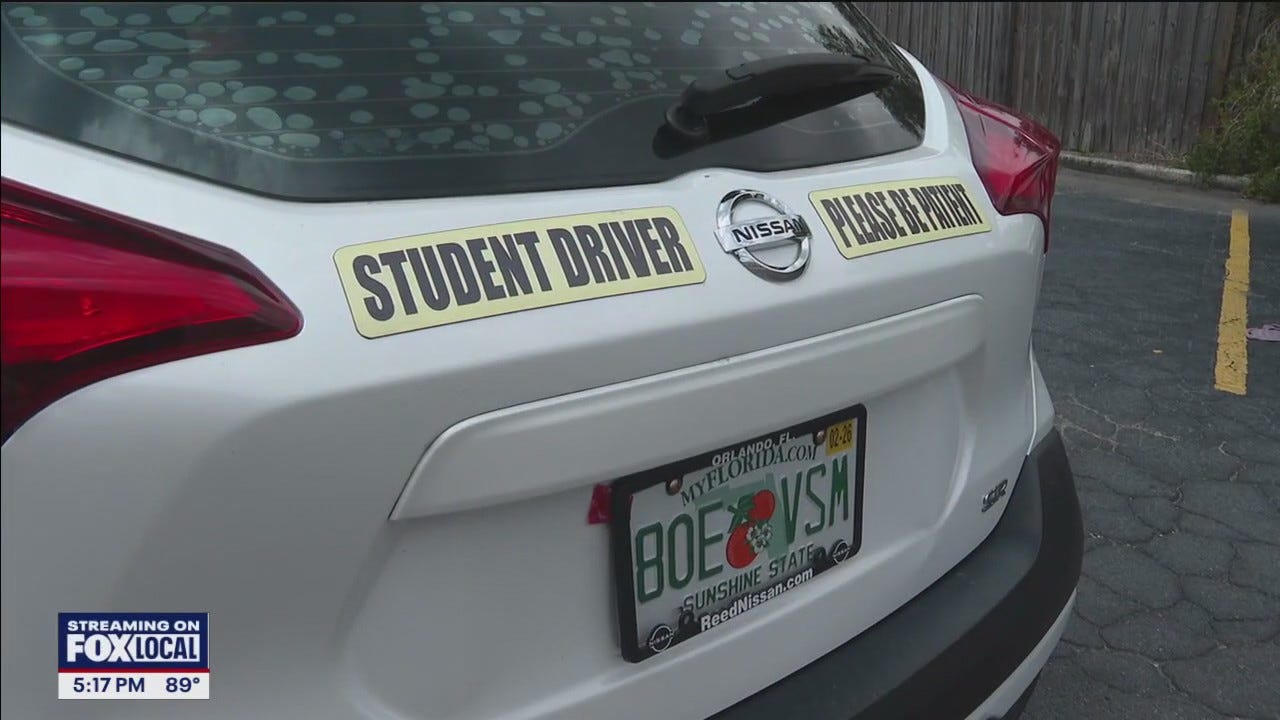A patchwork of laws govern requirements for new drivers in the United States. A wave of new laws have tightened some of those rules.

Florida teens face new driver education requirement
Florida teens now need to complete drivers education before they can get a permit.
Fox – 13 News
A new wave of state laws is enforcing stricter requirements for new drivers, but states still can’t agree on how much practice is needed.
While most states have some form of graduated driver’s licensing laws, ranging from as low as 20 and as high as 70 supervised hours, more states are looking into adopting tougher mandates for young people, said Jonathan Adkins, CEO of the Governors Highway Safety Association, a Washington, D.C.-based nonprofit.
Florida, Washington and New Jersey tightened up requirements for new drivers in 2025, but even these new laws have inconsistent requirements. The new laws come as some traffic safety advocates say the United States. would benefit from more uniform laws on the topic.
“There should be a national law for teen drivers,” said Cheryl Giles, the longtime owner of Lakeland Atlantic Driving School in Winter Haven, Florida, which conducts about 1,000 student driving tests annually. “We desperately need some consistency.”
Meanwhile, motor vehicle crashes continue to be among the leading causes of death for teens in the U.S., according to the Centers for Disease Control and Prevention (CDC). Teen drivers also face a disproportionately higher risk of crashes in comparison with older drivers, the National Highway Traffic Safety Administration (NHTSA) reports.
“I would call it an epidemic right now, and we all collectively need to do something to get it under control,” said American Driver & Traffic Safety Education Association Chief Executive Officer Brett Robinson, a traffic safety expert for more than 30 years.
Adkins said a recent GHSA report found that crash and fatality rates for drivers under 21 have “improved drastically” between 2002 and 2021, but he mentioned there has been a slight uptick in teen driver-related deaths across the country in 2022 and 2023.
“We’re not at a crisis point yet, but it is of concern and we want to continue to look at this more carefully,” Adkins said.
‘I lost my son’
Safe teenage driving advocate Tammy Gweedo McGee of Hampton Roads, Virginia, has spent several years pushing lawmakers for safer teen driving laws.
McGee’s teenage son, Connor, was killed in a 2019 car crash.
The 16-year-old was a passenger in a car with two other teens who also died in the crash when the vehicle, traveling upwards of 70 miles per hour, hit a tree and flipped over. Investigators later found that the teen driver Connor rode with was unlicensed.
“He went to a homecoming dance and never came back,” McGee told USA TODAY. “I lost my son in an instant.”
McGee now oversees a nonprofit foundation that educates new teenage drivers and their parents on the dangers of destructive driving decisions. As a leader with Families for Safe Streets, McGee has also helped pass state legislation. This includes backing an updated Virginia law on July 1, stating that a person could be criminally charged if they knowingly allow someone to drive without a license or learner’s permit.
A wave of new laws for young drivers
How much practice do young drivers need? Many states put the number at a 50-hour supervised driver mandate, Adkins said, citing a study by the Insurance Institute of Highway Safety (IIHS).
Some require more than that, according to IIHS data. Pennsylvania has a mandatory 65 hours of driver supervision, and Maryland and North Carolina each have 60 hours. Maine requires 70 hours.
Meanwhile, Iowa has a 25-hour supervised driving mandate, and Kansas has 20. Two states, Arkansas and Mississippi, have none, the IIHS reported.
But supervised hours aren’t the only part of licensing requirements. Driver’s education, age requirements and other details about who qualifies for a learner’s permit are all in play. A few states have tightened up their requirements in 2025, including:
- Florida: An updated law calls for teens 15 and up to now complete a six-hour driver’s education course before they can receive a learner’s permit. (Previously, the only prerequisite for a learner’s permit was completion of a four-hour course.) Additionally, Florida teens must also complete 50 hours of supervised driving, including 10 of those hours at night. The law took effect on July 1.
- New Jersey: Earlier this year, the state enacted a 50-hour driver’s supervision law for drivers under 21, joining numerous states, including California, Delaware, Idaho, and Wyoming, with similar driving measures.
- Washington: A law passed in May will expand mandatory driver’s education to drivers up to age 21 by 2030. Washington’s law will eventually mandate new license applicants up to age 25, a measure Adkins said is appropriate since some first-time drivers are waiting longer and may age out of some states’ graduated driver licensing requirements. “To have these additions for first-time drivers makes sense, regardless of your age,” Adkins said.
And American Driver & Traffic Safety Education Association CEO Brett Robinson tells USA TODAY he hopes Washington’s new law will someday become the benchmark across the country.
“That’s probably the most significant state bill in more than a decade,” Robinson said. “It just takes one state to do something for others to follow, as I do believe Washington state’s bill is the new standard.”
A federal solution?
Every state has its own transportation agency that handles drivers’ licensing, so standardizing laws for new drivers isn’t as easy as it sounds — even if some safety advocates find the inconsistency alarming.
“There should be more uniformity with teenage driving laws nationally,” McGee said. “Whether you are in Virginia, Florida, Utah, or even in the most rural parts of the country, the roads can be very dangerous places, especially when you don’t fully understand the dangers of driving.”
Adkins, head of the Governors Highway Safety Association, believes teen driving laws should remain under state authority.
“We see this more as a state issue, not as a federal issue,” Adkins said. “It’s just not even on the table.”
And Robinson, the traffic safety expert and also co-founder and president of Highway Safety Services (HSS), a Pennsylvania-based consulting company, believes a federal teen driver law is unlikely.
“To me, federal legislation would be wonderful, but we’re certainly not going to see that in the next decade,” Robinson said. “It would definitely take an act of Congress, and I just don’t see that happening.”
Florida’s teen driver law comes as another state, Washington, passed a law in May that will expand mandatory driver’s education to drivers up to age 21 by 2030. Washington’s law will eventually mandate new license applicants up to age 25, a measure American Driver & Traffic Safety Education Association Chief Executive Officer Brett Robinson tells USA TODAY he hopes will someday become “the new standard across the country.”
“We have to start somewhere. We see these teens get distracted so easily, even when they are in the car with us,” said Cheryl Giles, the longtime owner of Lakeland Atlantic Driving School in Winter Haven, Florida, which teaches about 700 teens and conducts about 1,000 student driving tests annually. “We hope this brings about more changes.”
“It’s encouraging to see more states prioritizing enhanced education for new drivers. This helps teens develop critical skills that can reduce crash risks during their early years behind the wheel,” Megan Muhlbach, program coordinator for the Florida Teen Safe Driving Coalition, a program funded through the state’s transportation department and NHTSA. “(These laws) also encourage important conversations between parents and teens about safe driving habits, including safety belt use, avoiding distractions, and the dangers of speeding or impaired driving.”
More states are looking into tougher measures for teen drivers
And though Adkins said a recent GHSA report found that crash and fatality rates for drivers under 21 have “improved drastically” between 2002 and 2021, he mentioned there has been a slight uptick in teen driver-related deaths across the country in 2022 and 2023.
“We’re not at a crisis point yet, but it is of concern and we want to continue to look at this more carefully,” Adkins said.
Expert: Washington’s updated driver’s ed law ‘most significant’ in a decade
As other states’ teen driving measures have garnered more attention this year, experts say Washington state’s new law to improve driver safety could be a model nationwide someday.
Signed in May, the new law will expand the state’s mandatory driver’s education to drivers up to age 21 by 2030, starting with 18-year-olds in 2027. Currently, only 16- and 17-year-olds must take driver’s education before receiving their first license.
The law also requires safe driving courses for young drivers who accumulate traffic tickets. Also starting in 2031, drivers under the age of 21 will be required to take a traffic safety “refresher course” to retain their license.
A Washington state report found that while people between the ages of 15 to 24 make up 10.6% of drivers, they were involved in crashes that resulted in 26% of all fatalities and 29% of all serious injuries between 2020 and 2022.
Although the legislation expands mandatory driver training to 21, the goal is to eventually expand the law to age 25, state officials contend.
“That’s probably the most significant state bill in more than a decade,” said Robinson, the national traffic safety expert, about Washington’s comprehensive new law. “It just takes one state to do something for others to follow, as I do believe Washington state’s bill is the new standard.”
New Jersey law mandates young drivers complete 50 hours of practice
In February, a New Jersey law mandated that drivers under the age of 21 complete 50 hours of supervised driving practice, also including 10 hours at night, before they can get a probationary license. A parent, guardian, or supervising driver must certify those hours.
New Jersey Governor Phil Murphy signed the law, which stipulates that supervised driving needs to be completed over six months. The new legislation updated the state’s Graduated Driver License program in January 2024.
“More practice leads to safer, more capable drivers, which, in turn, leads to safer roads for all,” said Acting New Jersey Motor Vehicles Commission Chief Administrator Latrecia Littles-Floyd in a statement in January.
Drivers have to be at least 17 years old to complete 50 hours of supervised driving practice and pass the road test before qualifying for a probationary license, state officials said.
The state requires those with a probationary driver’s license to continue unsupervised driving for one year. After that period, it can be upgraded to a basic driver’s license online.
Simon Miyerov, the owner of Drive Rite Academy, a driving school in nearby New York City, believes New Jersey’s law could lead to fewer accidents.
“Not every driver has been taught properly,” Miyerov said. “We need to fix it and teach drivers at the earliest stages possible.”
